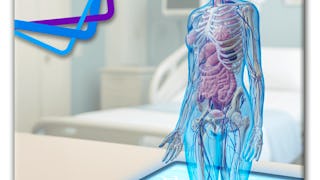This course gives you access to an exploration of physiological systems from the perspective of overall health and wellness. In particular, a focus on yoga, meditation and mindfulness as a therapeutic intervention in chronic illness and long term treatment. This course is intended for yoga practitioners and teachers, as well as college students and medical practitioners looking for a deeper understanding of the physiological benefits of yoga. The value of taking this course is to understand the impact that yoga can have on reducing stress, and aiding in healing or preventing physiological pathologies. Throughout this course, we will learn about different physiological systems and highlight yoga practices that can influence different systems and reduce pathology. Reading material will include analysis of scientific studies that have successfully utilized yoga practice as a tool for treatment of various illnesses such as: hypertension, stress, diabetes, insomnia, chronic pain and PTSD. In order to understanding these conditions, lectures will provide a complete understanding of the correlating physiological system. The weekly course assignment will include physiology lectures, a weekly yoga practice, suggested readings, and optional discussions for a total of 3-5 hours per week. The course will provide a tremendous amount of information and hands on experience for those interested in alternative health perspectives and a more in depth scientific understanding of this ancient healing method.


Engineering Health: Introduction to Yoga and Physiology



Instructors: Alexandra Seidenstein
69,376 already enrolled
Included with
(535 reviews)
What you'll learn
Identify the role, structure, and function of human physiological systems
Identify the the conditions and presentation of normal and abnormal functioning of human physiological systems
Examine underlying physiological mechanisms that connect healthy functioning to yoga practice
Practice yoga that targets therapy, prevention, and overall wellness
Skills you'll gain
Details to know

Add to your LinkedIn profile
63 assignments
See how employees at top companies are mastering in-demand skills

There are 14 modules in this course
What's included
2 videos1 reading1 assignment
The focus of this module is to provide a basic understanding to the workings of the trillions of cells that make up our body. The lecture provides an overview of the functioning components of the cell, energy production and signaling network of our cells. This gives us the ability to understand how cells work, and their purpose to understand cell stress and related pathologies. The yoga component of this module introduces the basics to the practice to allows us to begin building healthier cell programming and reducing cellular stress.
What's included
4 videos3 readings5 assignments1 discussion prompt
This module defines the basics of genetics in exploration of contributing factors to healthy chromosomes and genetic regulation. By explaining the role that stress can have on cells and chromosomal wellbeing, we provide a foundation for understanding how epigenetics can be affected by repetition and being to help to promote new regulatory factors.
What's included
7 videos5 readings6 assignments1 discussion prompt
In this module we break down a scientific article, so that we can better understand the components of a peer reviewed research paper. In understanding the sections of the paper, what they contribute to the scientific paper and discovery. In addition, the reader should be able to identify major conclusions and results from this research paper, and future studies.
What's included
8 readings2 assignments
In this module we will explore the basic components of the Nervous system from a cellular to a physiological level. Particularly, we will focus on the components of the nervous system that are aided by yoga and mindfulness modalities. The yoga aspect of the module will focus on supporting proper posture and minimizing back pain.
What's included
10 videos4 readings4 assignments1 discussion prompt
This module presents an overview of the respiratory system including both the molecular functioning as well as the overall mechanisms of breathing. In understanding how and why we breath, students will have a deeper understanding of the role that breathing has in stress reduction, physiological well being and overall health. The yoga component of this lesson will focus on different breathing techniques that can be utilized to optimize wellness.
What's included
5 videos4 readings4 assignments1 discussion prompt
The focus of this module is to provide a basic understanding of the cardiovascular system. The lecture provides an overview of the main components of the system, as well as the mechanisms behind muscle contraction. In order to understand associated pathologies, blood pressure is also highlighted in the class. The module features an interview with Dr. Marshall Hagins, who discusses the role that yoga and meditation can have on cardiovascular pathology such as hypertension. The yoga component of this module focuses on movement to increase circulation and increase your heart rate.
What's included
6 videos4 readings4 assignments1 discussion prompt
The focus of this module is to provide a basic understanding and introduction to the lymphatic and immune systems. The lecture provides an overview of the main components of the lymphatic system; vessels, glands and lymph components. In addition, an overview of the immune system focuses on the primary component. These two interconnected systems are highlighted in order to understand lymph circulation as well as pathologies, such as autoimmune diseases and inflammation. The yoga component of this module focuses on postures that have sweeping movement to increase lymphatic circulation, and ones that promote a calm and healthy immune system.
What's included
5 videos3 readings5 assignments1 discussion prompt
This module’s focus is to provide a basic understanding of the musculoskeletal system on both a physiological or macro level, as well as a micro level. In doing so, we will build an understanding of how yoga and meditation can help provide the foundation for a strong and health musculoskeletal system. In addition, this module features an interview with Orthopedic Surgeon, Dr. Michael Seidenstein, who will provide insight into how yoga can help treat and prevent orthopedic injury.
What's included
8 videos5 readings7 assignments1 discussion prompt
The focus of this module is to provide a basic understanding and introduction to the renal system and highlight other excretory systems. The lecture provides an overview of the functioning components of the renal system, the nephrons. The ability to understand how nephrons work, and their purpose to understand pathologies, such as high blood pressure. The yoga component of this module focuses on forward and back bends that have the ability to promote kidney health.
What's included
4 videos3 readings5 assignments1 discussion prompt
This module focuses on the overall purpose and structure of the digestive system organs, and the role of their accessory organs in digestion. We will explore yoga practices that can aid in promoting healthy digestion through movement. In addition, an overview of some pathologies associated with the digestive system, and how yoga can help enhance treatment.
What's included
3 videos4 readings5 assignments1 discussion prompt
The focus of this module is to provide a basic understanding of the endocrine and the reproductive system. The lecture provides an overview of the main components of the endocrine system; hormones, glands and tissues/organs that are affected. In order to understand associated pathologies, specific hormones are highlighted in the class. In addition, the module goes over impact of long term stress with an in depth description of the HPA Axis. The yoga component of this module focuses on relaxing movement to decrease stress and promote a healthy endocrine system.
What's included
6 videos4 readings5 assignments1 discussion prompt
The focus of this module is to provide a physiological understanding of the stress response. The lecture provides an overview of stress as controlled by the sympathetic nervous system and the HPA axis. This gives us the ability to understand how stress can impact our bodies on a cellular, as well as, systems level and discuss related pathologies. This module is enhanced by an interview with Dr. Marshall Hagins who discusses the impact of stress on general health as well as pain. The yoga component of this module introduces breathing and meditation techniques to decrease chronic stress, and improve our overall health.
What's included
5 videos3 readings6 assignments1 discussion prompt
In this module we will integrate everything we have learned in the previous modules to enhance our overall health and wellness. The focus of this module is on practicing a short but complete practice, that can be done on a daily or weekly basis. This yoga practice was designed as part of a hypertension and yoga study, where it was able to reduce hypertension. Being able to integrate this complete practice into your daily lives is a perfect practical summary of everything that has been practiced.
What's included
1 video4 readings4 assignments
Instructors



Offered by
Explore more from Basic Science
 Status: Preview
Status: PreviewDuke University
 Status: Free Trial
Status: Free Trial Status: Free Trial
Status: Free TrialNational Academy of Sports Medicine
 Status: Free Trial
Status: Free Trial
Why people choose Coursera for their career




Learner reviews
535 reviews
- 5 stars
86.16%
- 4 stars
11.40%
- 3 stars
1.12%
- 2 stars
0.18%
- 1 star
1.12%
Showing 3 of 535
Reviewed on Aug 14, 2024
It is an amazing course, even as a yoga instructor, I enjoyed the information that was shared and I will implement it as I grow in my career.
Reviewed on Jul 29, 2020
it was a great experience. I learned so many things and made me more aware of the importance of health and how each organ plays a crucial role. even the course structure was very good.
Reviewed on Dec 7, 2020
This is a very good course. I'm an yoga teacher and Im happy to learn this. I'm impressed alot by the researches show how yoga affect people health and help treating disease.

Open new doors with Coursera Plus
Unlimited access to 10,000+ world-class courses, hands-on projects, and job-ready certificate programs - all included in your subscription
Advance your career with an online degree
Earn a degree from world-class universities - 100% online
Join over 3,400 global companies that choose Coursera for Business
Upskill your employees to excel in the digital economy
Frequently asked questions
To access the course materials, assignments and to earn a Certificate, you will need to purchase the Certificate experience when you enroll in a course. You can try a Free Trial instead, or apply for Financial Aid. The course may offer 'Full Course, No Certificate' instead. This option lets you see all course materials, submit required assessments, and get a final grade. This also means that you will not be able to purchase a Certificate experience.
When you purchase a Certificate you get access to all course materials, including graded assignments. Upon completing the course, your electronic Certificate will be added to your Accomplishments page - from there, you can print your Certificate or add it to your LinkedIn profile.
Yes. In select learning programs, you can apply for financial aid or a scholarship if you can’t afford the enrollment fee. If fin aid or scholarship is available for your learning program selection, you’ll find a link to apply on the description page.
More questions
Financial aid available,

